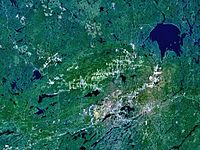
Photo from wikipedia
Abstract Magmatic Fe-Ni-Cu-Co sulfide melt inclusions are preserved within cumulate and intercumulate phases (apatite, plagioclase, olivine, ilmenite) in the mineralized Caribou Lake Gabbro, a marginal subalkaline-alkaline mafic-ultramafic rock assemblage that… Click to show full abstract
Abstract Magmatic Fe-Ni-Cu-Co sulfide melt inclusions are preserved within cumulate and intercumulate phases (apatite, plagioclase, olivine, ilmenite) in the mineralized Caribou Lake Gabbro, a marginal subalkaline-alkaline mafic-ultramafic rock assemblage that forms part of the multiphase Blatchford Lake intrusive suite, Northwest Territories, Canada. Three distinct styles of sulfide mineralization occur in the Caribou Lake Gabbro: (i) disseminated sulfides, (ii) semi-massive to massive sulfides, and (iii) trace sulfide “platinum-group element (PGE)-enriched” mineralization. Within all mineralization styles, the major mineral assemblage consists of pyrrhotite + chalcopyrite + pentlandite + magnetite + ilmenite. Trace metal phases identified in the disseminated and semi-massive to massive mineralization comprise sphalerite, galena, glaucodot-gersdorffite solid solution [(Co,Fe)AsS-NiAsS], molybdenite, tellurobismuthite (Bi2Te3), altaite (PbTe), electrum, nickeline, melonite (NiTe2), empressite (AgTe), and unidentified Pb-Se-Te, Bi-Te, and Pb-Te phases. No platinum-group minerals (PGM) were observed in any mineralization styles. Within coarse-grained olivine gabbro sulfide melt inclusions of primary origin occur in olivine and ilmenite, and secondary inclusions occur in plagioclase. Secondary sulfide melt inclusions also occur in cumulus apatite in pegmatitic gabbro. Sulfide melt inclusions consist predominantly of pyrrhotite, with lesser amounts and variable proportions of chalcopyrite, and cobaltian pentlandite (∼31–38 wt% Co), and magnetite. In a minority of inclusions, sphalerite, magnetite, and glaucodot-gersdorffite were also observed however, no PGM were observed in the sulfide melt inclusions. The metal tenors of sulfide melt inclusions and sulfide mineralization are comparable with respect to Cu concentration, with sulfide melt inclusions containing between 0.06 and 2.7 wt%, and mineralization containing between 0.54 and 2.9 wt% (recalculated to 100% sulfide). Cobalt concentrations are also similar in sulfide melt inclusions (950–4400 ppm) and mineralization (1350–3500 ppm). In contrast to Cu and Co, Ni is enriched in mineralization (0.94–2.1 wt%) compared to sulfide melt inclusions (0.13–0.59 wt%). The difference in Ni concentration suggests that the inclusions trapped a residual sulfide melt that had been compositionally modified by olivine crystallization and associated “trapped liquid shift effect” prior to inclusion entrapment. Notably, PGE concentrations in sulfide melt inclusions are very low (i.e., below limits of detection of LA-ICPMS; Using Cu and Pd bulk rock compositions for various mineralization styles, together with estimates of starting magma composition (S-undepleted tholeiite, and local, fine-grained, fresh gabbro), R-factors were estimated numerically. S-undepleted tholeiite (from published data) is too Cu- and Pd-rich to be a suitable starting magma composition to source disseminated and semi-massive to massive sulfide, and would require an initial (earlier) stage of metal depletion. Using the local gabbro as a starting magma composition estimate, the metal tenors of disseminated, and semi-massive to massive sulfide mineralization are estimated to have resulted from an R-factor of Low metal tenors of sulfide mineralization within the Caribou Lake Gabbro are likely the result of a magmatic system with a low R-factor, supported by low Ni in olivine and modelling of Cu and Pd systematics. In this case, sulfide melt inclusions predict the sub-economic PGE tenor of the sulfide mineralization as being a primary feature rather than the result of post-solidus downgrading by later metamorphic or hydrothermal fluids. More broadly, sulfide melt inclusions may serve as a proxy for sulfide metal tenor at different stages in the history of a magmatic system, providing a potentially valuable tool for exploration where post-entrapment changes may have modified bulk metal tenors, or where sulfide mineralization has not yet been located.
Journal Title: Ore Geology Reviews
Year Published: 2019
Link to full text (if available)
Share on Social Media: Sign Up to like & get
recommendations!